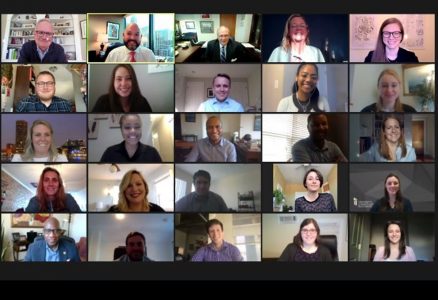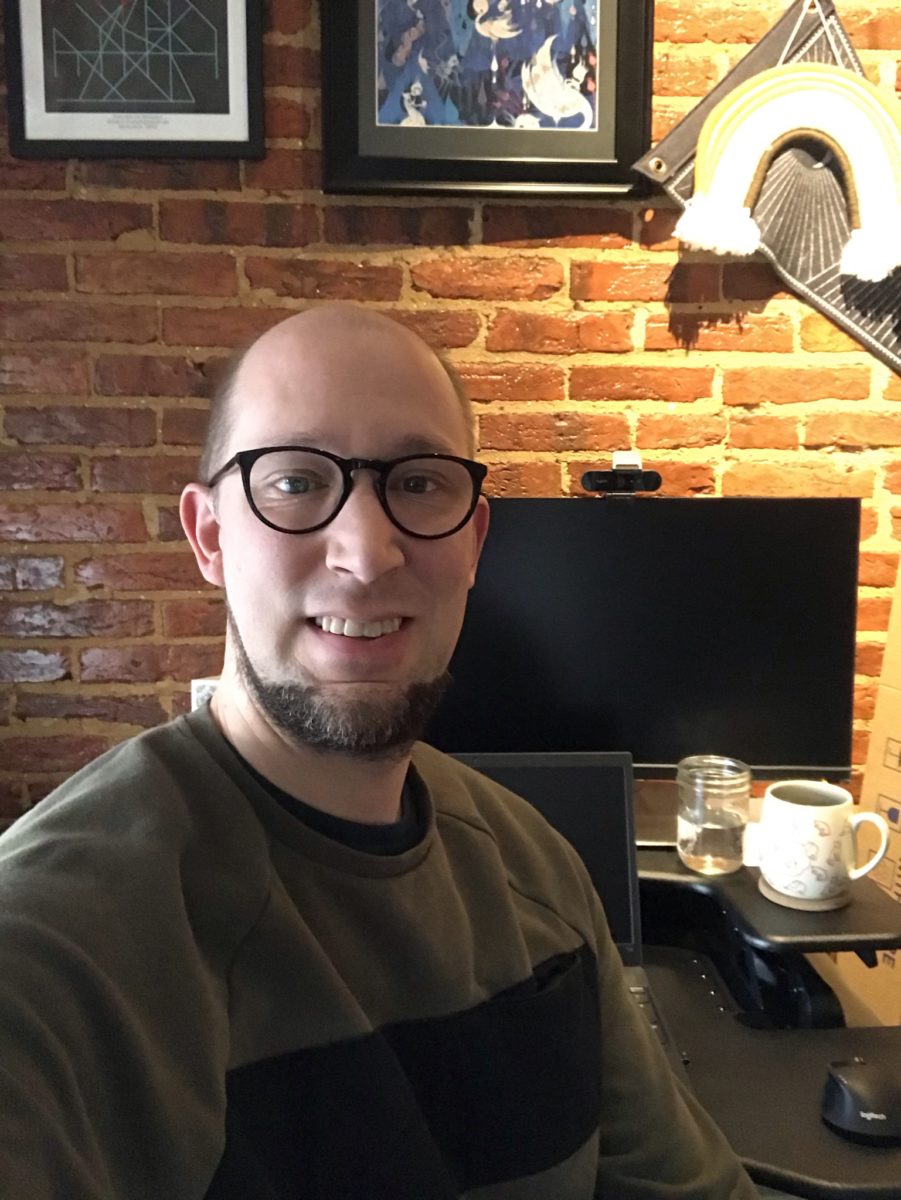Power Moves is a column where we chart the comings and goings of talent across the region. Got a new hire, new gig or promotion? Tell us: baltimore@technical.ly.
The pandemic has accelerated lots of trends that were already playing out. For technologists and knowledge workers, one of the highest-profile shifts has been the move to make remote work a norm.
This has started at the top: One-by-one, the household-name tech companies have turned pandemic WFH shifts into long-term policies that are allowing remote work to become more permanent, and opening up hiring in cities beyond the Silicon Valley and New York HQs where many of these companies are clustered.
So we got interested on hearing about a recent new role for Baltimore-based technologist Barry Wright, III: In mid-March, he joined Spotify. Wright is the group product manager in the audio streaming company’s content platform division. As he puts it, responsibilities include “setting product strategy, managing and developing a team of product managers, and delivering products to Spotify’s internal teams responsible for ensuring the quality, safety, and legality of the Spotify audio catalog,” which includes music and podcasts.
Wright’s career shows a trajectory of working with national companies from a base in Baltimore. He spent the past nine years working in adtech, which has been an area of particular strength for Baltimore-grown companies. Wright started nine years ago as a product manager at Videology, the Locust Point-based firm building new tools for video-based digital advertising, and grew to a VP role in product management. When Videology was acquired by advertising platform Amobee in August 2018, Wright stayed on to lead that company’s broadcast solutions product team.
These roles included work with well-known global brands. At Amobee, Wright worked with global broadcasters like Disney, Fox, Bell Media (Canada) and ITV (UK). With Spotify, he’s moving to work with a company that makes a product that’s a staple of many smartphones. And he’s still doing it from Baltimore. The difference, of course, is that Spotify isn’t based here.
Yet Wright said he will be staying in Baltimore “indefinitely,” even after offices open. Spotify is embracing this, having recently launched a new Work from Anywhere program, where new and current employees can work from an office or home going forward. When more travel starts happening, Wright expects he’ll be going to the company’s offices in New York, London, and Stockholm to meet with his team. But on a day-to-day basis, he’ll be working from home.
As he sought a new role, Wright prioritized growth opportunities and more direct consumer-facing impact. But location was also important: He recently started the nonprofit theater called Highwire Improv, so he was rooted to the city. So along with looking locally, this led him to seeking out remote companies, which in part shaped the job search.
It affects the companies one seeks: Wright said companies that already have multiple major offices where folks beyond sales teams are clustered are typically more prepared for remote jobs. LinkedIn can also help to reveal whether a company has a distributed workforce, and the scale of it. With Spotify, Wright found such a company that had large teams clustered in different cities — Stockholm, London and New York City.
“My rationale was that the team was split across three major offices, so even if I worked out of one, I’d be doing distributed work with the other two,” he said.
Remote work also becomes part of the process. A resume and interview can be tailored to show remote work readiness. Including elements such as communications skills across multiple modes, strategy or process alignment successes and prior distributed work experience can stand out to hiring managers.
Then there’s the work itself. Working from home is not new territory for Wright. After all, Amobee’s team was working remotely during the pandemic, and even Videology had a distributed team. Given that he has experience, we asked Wright about some advice for others who may be getting ready to work remotely over the long haul. The familiar advice, he said, is often repeated for a reason: Investing in asynchronous communications tools, over-communication with teams, setting regular times to sync both personally and professionally and scheduling regular offsite meetings for strategic thinking and team building are key.
But when it comes to having everyone working from home, there are a few important things to consider. Wright shared the following lessons from the last year:
- For many things, office locations don’t matter, but time zones do. When a team has multiple time zones, Wright advises to “act more aggressively than you think you need to in order to mitigate time zone gaps.” This includes blocking off convenient overlapping hours, and, as he puts it, “specifically work with employees with awkward schedules to make sure they are taking care of themselves.”
- Now is the time to invest in 1on1s. You’ve probably tried all of the creative Zoom work hangouts by now. By contrast, Wright said, “1-1 meetings are lower stress, can be done audio-only or on a walk, and can retain connections when people are feeling disconnected.” They’ll be especially important when folks are back in offices.
- Pre-reads and agendas equal shorter meetings. “Shorter meetings equals less video fatigue, more resilience, and less stress. If you’ve been thinking about getting stricter with meeting prep, now is a time you’re likely to get buy-in,” Wright said
###
Business advocacy organization the Greater Baltimore Committee recently welcomed 33 emerging leaders to the 2021 cohort of its Next Up program.
The program, which includes local business, nonprofit and civic pros who are under 40, provides growth opportunities throughout the year for members of the cohort, who are nominated by GBC member company CEOs.
“The Greater Baltimore Committee’s Next Up program identifies the best and brightest emerging young talent in the Baltimore region and helps them advance their personal and professional development, while also expanding their networks,” said Donald C. Fry, the Greater Baltimore Committee’s CEO, in a statement. “The program also exposes these young executives to the many opportunities and benefits GBC membership provides companies and employees.”
Programming for 2021 will include seminar-style talks from business, civic and government leaders in the region, in-depth discussions of local and regional business and civic issues and networking opportunities.

Here are the members of the 2021 cohort, which is GBC’s largest yet. We spotted a few leaders from local tech outfits like Flywheel Digital, Johns Hopkins Tech Ventures, TEDCO and UM Ventures:
- Will Baugher — Howard Hughes Corporation, VP
- Jacqueline Bowie — National Aquarium, board engagement director
- Ernest Brevard, EdD — Morgan State University, special assistant to the VP and director of budget, planning and operations
- Sierra Brown — Mercy Hospital, practice manager
- Mercedes Bucelato — The Center Club, director of finance
- Samuel Burris — University of Maryland Medical System, senior community engagement manager
- Jonathan Carter — Family League of Baltimore, senior director of strategic operations and compliance
- Averil Christens-Barry — Ulman Foundation, director of external relations
- Jennifer Curry — Baker Donelson Bearman Caldwell & Berkowitz; shareholder, vice chair of labor and employment
- Laurie Davidow — Weller Management, director of property management
- Nathan Dennies — AIA Baltimore, associate director
- Elvis Guzman — The Harry and Jeanette Weinberg Foundation, program officer
- Cassy Haber – TEDCO, marketing and communications coordinator
- Stacey Herman — Kennedy Krieger Institute, director of neurodiversity and community workforce development
- Jennifer Hobbs — The Penn-Mar Foundation, director of marketing and communications
- Danny Hoffman — Flywheel Digital, senior business manager
- Kerry Ingram — Johns Hopkins Technology Ventures, marketing and operations coordinator
- LaShawn Jones — Boy Scouts of America: Baltimore Area Council, district executive
- Jonathan Law — Associated Black Charities, workforce initiatives coordinator
- Dana Lewis — NorthBay Education, director of media and enrichment
- Sarah Mendelsohn – MATClinics, practice administrator
- Claire Murphy — UM Ventures, Baltimore, director of strategic marketing
- Zachary Peters — Maryland Auto Insurance, chief of staff
- Martina Reilly — Moseley Architects, associate
- Eric Rosenberg – Truist, business bank leader
- Brittany Sink — Morris & Ritchie Associates, Inc., landscape architect
- Melissa Snyder — Alzheimer’s Association of Greater Maryland, development manager
- Eric Stephenson — Southway Builders, project manager
- K. Alexander Wallace — Z+C LLC, associate lobbyist
- Christopher Warman — Baltimore Community Foundation, finance assistant
- Regina Webb — Kaiser Permanente, program manager
- Laura Wheaton — Ayers Saint Gross, associate
- Jennifer Zohorsky — Rosenberg Martin Greenberg, partner







